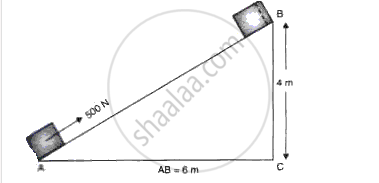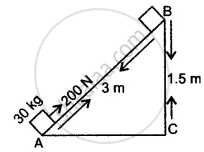Advertisements
Advertisements
Question
Why is less effort needed to lift a load over an inclined plane as compared to lifting the load directly?
Solution
Less effort is required because for a given height ‘h’ as longer is the length ‘l’ of the inclined plane, smaller is the angle of inclination, therefore, greater is the mechanical advantage, so lesser will be the effort required. As we know
Mechanical Advantage = l/h.
APPEARS IN
RELATED QUESTIONS
Look at the activity below. Reason out whether or not work is done in the light of your understanding of the term ‘work’.
A sailboat is moving due to wind energy.
The S.I. unit of work is
No work is done by a force if the body
State two conditions when no work is done by a force.
The moon is revolving around the earth in a circular path. How much work is done by the moon?
A boy of mass 40 kg climbs up the stairs and reaches the roof at a height 8 m in 5 s. Calculate:
- the force of gravity acting on the boy,
- the work done by him against the force of gravity,
- the power spent by boy. (Take g = 10 m s-2)
A person of mass 50 kg climbs a tower of height 72 metres. Calculate the work done. (g = 9.8 m s−2).
When do we say that work is done? Write the formula for the work done by a body in moving up against gravity. Give the meaning of each symbol which occurs in it.
The velocity of a car increases from 54 km/hr to 72 km/hr. How much is the work done if the mass of the car is 1500 kg?
State the conditions of equilibrium for a rigid body.
Give two examples of work done.
On what factors does the work done by a force depend?
A weight lifted a load of 200 kgf to a height of 2.5 m in 5 s. calculate: (i) the work done, and (ii) the power developed by him. Take g= 10 N kg-1.
A block of mass 20 kg is pulled up a slope (fig.12) with a constant speed by applying a force of 500 N parallel to the slope. A and B are initial and final positions of the block.
(a) Calculate the work done by the force in moving the block from A and B.
(b) Calculate the potential energy gained by the block.

In what way does an ‘Ideal machine’ differ from a ‘Practical machine’?
What do you understand by the term energy? Is energy a scalar or vector? How is the energy possessed by a body measured?
A block of mass 30 kg is pulled up a slope, as shown in diagram with a constant speed, by applying a force of 200 N parallel to slope.
A and B are initial and final positions of block.

(i) Calculate the work done by force in moving the block from A to B.
(ii) Calculate P.E. gained by block. [g=10ms-2]
